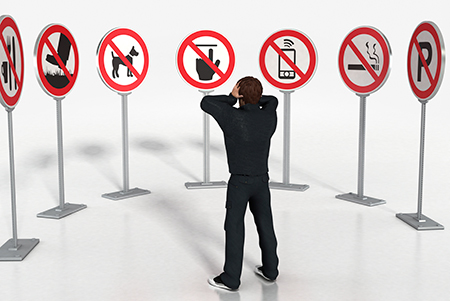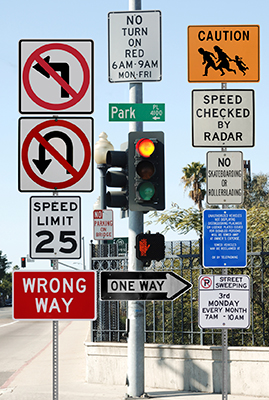Over-Instructing
 As noted in the previous Behavior Watch commentary, rules, a.k.a. instructions, are valuable in establishing and maintaining behavior wherever people live and work. Rules are created to both facilitate and eliminate behavior: “DO empty your tray here” or “DON’T spit on the sidewalk!” Sometimes, rules are adhered to overly rigidly – we have all encountered the bureaucrat at the county court house who insists on following the letter of the law even when a little flexibility would be better for all concerned. Two reasons that rules are not followed are that they sometimes are (a) inconsistent or (b) over-abundant. I’ll consider the former in my next commentary, focusing here on what I call “over-instructing.”
As noted in the previous Behavior Watch commentary, rules, a.k.a. instructions, are valuable in establishing and maintaining behavior wherever people live and work. Rules are created to both facilitate and eliminate behavior: “DO empty your tray here” or “DON’T spit on the sidewalk!” Sometimes, rules are adhered to overly rigidly – we have all encountered the bureaucrat at the county court house who insists on following the letter of the law even when a little flexibility would be better for all concerned. Two reasons that rules are not followed are that they sometimes are (a) inconsistent or (b) over-abundant. I’ll consider the former in my next commentary, focusing here on what I call “over-instructing.”
 Everyone who has grown up with a caregiver – mother, father, maiden aunt, whoever – knows exactly what I am talking about. I hasten to point out that, among all members of the human race, I am probably the only father in history that never repeated or elaborated on instructions to my three children when they were growing up. Nope, once was always enough … What’s that you say? Well, no, you really don’t need to ask my children about this!
Everyone who has grown up with a caregiver – mother, father, maiden aunt, whoever – knows exactly what I am talking about. I hasten to point out that, among all members of the human race, I am probably the only father in history that never repeated or elaborated on instructions to my three children when they were growing up. Nope, once was always enough … What’s that you say? Well, no, you really don’t need to ask my children about this!
It isn’t just our caregivers and us. We live in a society that sometimes is instruction crazy. How many emails or text messages do you get in a given day directing you, reminding you, or warning you of things that need to be or should not be done? On my way to work, which is maybe 2.5 miles from my house, tops, I counted over 50 traffic control signs, excluding signs with street names on them and advertising billboards and placards. Taken individually, each sign provides useful instructions or rules about traffic flow, safety, or the locations of things.
 But we all know what happens when faced with such a dazzling array of data. It is what we might call “stimulus satiation” or information overload. Too much data is not useful. It leads to people shutting down and not responding to any of it. We know from a host of experiments in psychology that even important stimuli can be “lost” by a listener or an observer when there is too much background noise. Thus, it is much easier to hear pure tone when the background noise is low as opposed to loud. It is easier to find the letter “q” on an otherwise blank page than it is on a page filled with other letters or words. If we keep the important stimulus, the “signal” at the same level (that is, constant) and vary the type and extent of background noise, a person’s detection of the stimulus changes. The more noise, the less detectable is the stimulus, and the less noise, the more detectable it is. This has obvious implications for signage: If you want an instruction to “mean something” then make it unique. This is why advertisers are forever coming up with creative variations like three-dimensional cow figures standing out from the billboard on which it is attached.
But we all know what happens when faced with such a dazzling array of data. It is what we might call “stimulus satiation” or information overload. Too much data is not useful. It leads to people shutting down and not responding to any of it. We know from a host of experiments in psychology that even important stimuli can be “lost” by a listener or an observer when there is too much background noise. Thus, it is much easier to hear pure tone when the background noise is low as opposed to loud. It is easier to find the letter “q” on an otherwise blank page than it is on a page filled with other letters or words. If we keep the important stimulus, the “signal” at the same level (that is, constant) and vary the type and extent of background noise, a person’s detection of the stimulus changes. The more noise, the less detectable is the stimulus, and the less noise, the more detectable it is. This has obvious implications for signage: If you want an instruction to “mean something” then make it unique. This is why advertisers are forever coming up with creative variations like three-dimensional cow figures standing out from the billboard on which it is attached.
 No, you don’t have to yell to make it more likely your rules or instructions will be followed. But, perhaps you should revisit them for redundancies with other instructions, for their clarity, and to see how they fit with other instructions the instructee is given. It may be that less is more when it comes to rules.
No, you don’t have to yell to make it more likely your rules or instructions will be followed. But, perhaps you should revisit them for redundancies with other instructions, for their clarity, and to see how they fit with other instructions the instructee is given. It may be that less is more when it comes to rules.



